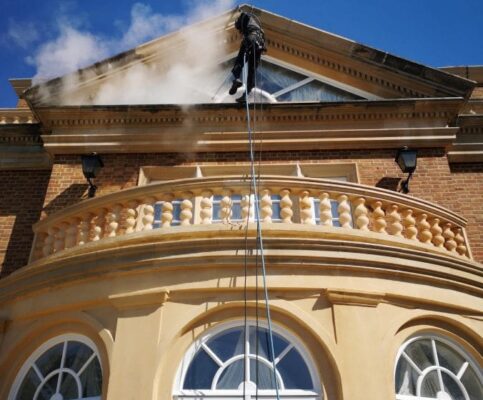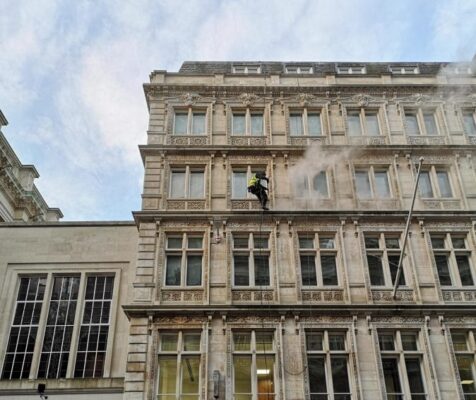View More SErvices Contact Us
Facade Cleaning in Marylebone
Cleaning building facades from top to bottom, no matter how tall your building.
Natural stone facade cleaning in Marylebone can be accessed and cleaned efficiently and effectively by using rope access methods. Using this method, the need for local authority permits is totally eradicated, allowing works to proceed immediately. Using professional stone cleaning equipment we can roll back the years to make your building look like new.
Brick cleaning
Brick buildings become dirty as much as any other building. We will not only clean away the dirt and grime, we can revitalise the colour. Using a range of bio-degradable chemicals, we can restore the colour of red or yellow bricks.
Contact UsGlass facade cleaning in Marylebone
Glass facade cleaning in Marylebone takes place by abseilers using traditional window cleaning tools. External windows, internal atriums, after builders cleaning or regular maintenance cleans, our abseilers are experienced in all manner of glass cleaning.
Contact UsAluminium cladding cleaning
Aluminium cladding in Marylebone can become extremely dirty over time. Warehouses that have many lorries coming and going will become soiled with traffic film. Using our steam cleaning systems, this grime is washed away leaving a lasting first impression for your visitors.
Contact UsOur services
Rope Access Facade Cleaning Services for Marylebone And Surrounding Counties

Residential property Stone Facade Cleaning
Façade cleaning at this residential property in Marylebone, which was not of any great height but, had no access for other forms of access equipment. Abseiling was the solution and the results were outstanding.

Stone Steam Cleaning in London
This beautiful natural stone building was looking tired from the day to day London traffic. Rope access was seen as the most cost-effective method of access.

Concrete Facade Cleaning in Marylebone
This car park in Essex was filthy. It hadn’t been cleaned, ever. As the access to three elevations was extremely tight, abseiling was the only method that could achieve the results.

Facade Cleaning in Marylebone
A new acquisition for our client needed a freshen up. Out of hours abseiling was the best way to clean this building in the heart of the City of London.
Brick colour restoration
Before colour restoration
This client requested a test patch before assigning us the job of cleaning their building. We carried this out with amazing results.
After colour restoration
These are the pictures of the test patch that we sent to the client. Her reaction was simply ‘WOW’. That’s the perfect response for us.
Torik Stone Cleaning System Features
150 degrees centigrade steam cleaning power
Provides a continues flow of superheated water to penetrate stone and deep clean, removing organic growth & ground in dirt.
We use Tensid (uk) Ltd
Providers of specialist cleaning equipment and specialist cleaning chemicals to professionals.
Get In Touch
Fill in the form below and we’ll be in touch within 24hrs of receiving your message.
Facts About Marylebone
Marylebone History
Marylebone gets its name from a church dedicated to St Mary, represented by St Marylebone Parish Church. The original church was built on the bank of a small stream or “bourne”, called the Tybourne or Tyburn. This stream rose further north in what became Swiss Cottage. Eventually running along what became Marylebone Lane, which preserves its curve within the grid pattern.
Early in the 13th century it was held by Robert de Vere, 3rd Earl of Oxford. At the end of the 15th century, Thomas Hobson bought up the greater part of the manor. In 1544 his son Thomas exchanged it with Henry VIII, who enclosed the northern part of the manor as a deer park.
General Info
Marylebone is an area in the West End of London, in the City of Westminster. Oxford Street, Europe’s busiest shopping street, forms its southern boundary. Originally an ancient parish and latterly a Metropolitan Borough, it merged with the Metropolitan Boroughs of Westminster and Paddington to form the new City of Westminster in 1965.
Also home to the historical Nottingham Place. It is characterized by its ornate red buildings, leading up to Marylebone Road. Most recently, in 2017–18, Number 28 was home to notable Indian artists, musicians, diplomats, and all-around Renaissance men. Their tenure was prematurely cut short. Wimpole Street runs from Henrietta Place north to Devonshire Street. Becoming Upper Wimpole en route – the latter where Arthur Conan Doyle opened his ophthalmic practice at number 2 in 1891.



